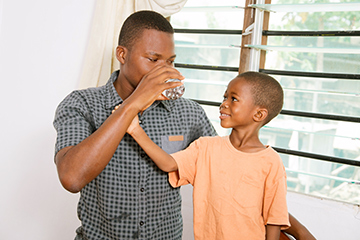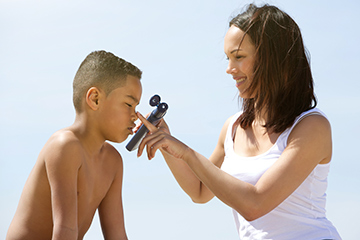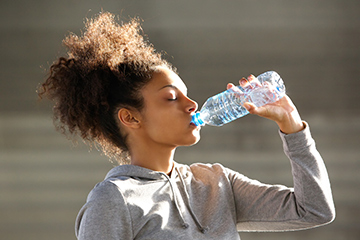Staying safe in the sun
Staying in the sun for longer periods of time can cause sunburn and if you’re not properly hydrated, you can suffer from heat stroke or heat exhaustion.
We have a few tips to keep you and your family hydrated and protected from the sun during the hot summer months. With the start of school holidays, it’s also important for your children to be made aware of the dangers that too much sun exposure can cause.
Understanding heat exhaustion
Heat exhaustion happens when your body has been exposed to high temperatures, and is unable to regulate to the normal temperature by perspiring (sweating).
It is not as severe as heat stroke, but if it’s not treated quickly, it can turn into heat stroke.
People who are at risk of heat exhaustion or heat stroke are babies, elderly people, people who work outdoors and those who exercise in places with poor ventilation and excessive heat.
 Symptoms of heat exhaustion
Symptoms of heat exhaustion
If you’re worried that you or a loved one might be suffering from heat exhaustion be on the lookout for these symptoms:
- nausea or vomiting
- a pale skin colour
- tiredness
- weakness
- headaches
- muscle cramps
- dizziness
What is heat stroke?
Heat stroke is more severe than heat exhaustion and should be treated as a medical emergency. Symptoms include fever and unconsciousness. Anyone suspected of suffering from heat stroke should be taken to the nearest local hospital or clinic as soon as possible to seek medical attention. You can also call 10177 from a landline or 112 from a cellphone for an ambulance.
General prevention of heat exhaustion and heat stroke
If you are in the sun or outdoors on hot days make sure you:
- wear a hat to protect your head from the sun or use an umbrella for shade,
- use a small wet towel under your hat or on your shoulder to keep you cool,
- drink as much water as possible in order to stay hydrated,
- always carry lots of water with you wherever you go, and
- if you feel yourself still getting thirsty while you are already drinking water, make use of the rehydration solution by mixing 1 litre of water, 8 teaspoons of sugar and ½ teaspoon of salt in a clean bottle.
Tips for babies and children
Children under the age of 2 years old are vulnerable of becoming dehydrated quickly. This can lead to dangerous circumstances especially if a child has diarrhoea or if they’re vomiting. Make sure you use the sugar and salt solution to help them stay hydrated while you look for medical attention at your nearest clinic or hospital.
Babies
Breastfeeding mothers who have babies should:
- remember to drink lots of water,
- take their babies to the clinic should their babies experience diarrhoea or vomiting,
- keep their babies indoors or in the shade,
- keep their babies cool by wiping them with a damp clean cloth, and
- dress their babies in light clothing.
Older children
Parents who have older children should:
- keep their children in the shade,
- try to avoid letting their children do sporting activities on extremely hot days,
- make sure their children practices sun safe methods such as making use of sunblock and staying out of direct sunlight between 11am and 3pm.
Tips for those working outside
If you are required to work outside you should:
- cover your head or place a wet towel under your hat to help keep cool,
- make sure you have lots of clean water to drink,
- take regular short breaks in the shade, and
- keep a spray bottle filled with water to spray on your face and body should you get hot.
Tips for commuters
If you are travelling on the road for a few hours, make sure you are well prepared by:
- keeping pieces of fruit cool in your fridge as a refreshing snack,
- freezing water bottles which could later be used as ice packs,
- keeping a spray bottle or two filled with clean water which could be used to cool yourself off in the car, and
- having a small wet towel in your car that can keep your passengers cool.


